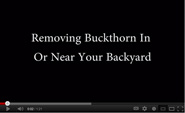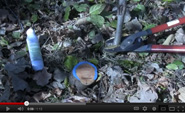BUCKTHORN
Why Remove Buckthorn?
by: Dianne Plunkett Latham
Children – Buckthorn berries, bark and roots are toxic.

The berries cause severe cramping and diarrhea in humans. Keep small children out of areas where buckthorn berries fall, as the blue/black berries may be mistaken for blueberries and accidentally eaten. Although only the female trees produce berries, the male trees must be removed as well to prevent female trees elsewhere from being fertilized. If you can’t remove all the buckthorn, start with the female trees.
Birds – Buckthorn is a starvation food for birds. They eat buckthorn berries only when food sources are low, especially in late winter. Buckthorn berries cause diarrhea and weakens birds. The blue stains on houses and sidewalks are the result of droppings from birds eating buckthorn berries. Bird numbers decline in areas infested by buckthorn, since food sources and nesting sites are greatly reduced.
Wildflowers and the Next Generation of Trees – Buckthorn has an allelopathic chemical in its roots that suppresses the growth of surrounding plants, much like black walnuts do. Between the chemical suppression effect and being shaded out by buckthorn, wildflowers are diminished, and the next generation of native tree seedlings never gets started. When the mature trees in a buckhorn infested woodland reach the end of their lifespan, there are few replacement trees. Because buckthorn is toxic, wildlife do not eat it and disproportionately browse the native shrubs and wildflowers, further reducing the few native plants that remain. Eventually all that remains is a predominately buckthorn woodland.
Fall Color – Staying green an average of 58 days longer than our native species, common buckthorn provides little fall color. Spreading from urban areas, buckthorn is replacing our woodlands and their beautiful fall colors. Buckthorn seeds came from ornamental buckthorn hedges planted before the shrubs were banned in Minnesota. These hedges should be removed. Nearly all deciduous trees/shrubs that are still green after mid October are buckthorn. Watch for it in the fall as you drive around metro areas and natural areas.
Crime – Buckthorn eventually forms dense, thorny thickets, which you cannot easily walk through. In addition to shading out native plants, it provides cover for criminal activity in parks and other areas.
Privacy – Homeowners maintaining buckthorn thickets for privacy should consider conifers, which offer much better privacy, as they stay green all year. Being deciduous, buckthorn offers no privacy during winter.
Property Values – Buckthorn infestations reduce property values. Savvy buyers ask that buckthorn be removed before purchasing a property, or ask to lower the sale price by the cost of buckthorn removal. If any homeowner maintains this invasive weed, it will infest their neighbor’s property and nearby public property as well, since birds can carry buckthorn berries up to 1/3 mile. The longer you wait, the more you will have, and the more expensive removal will become.
Asian Lady Beatles – Tired of vacuuming them up in your home in the fall? The Asian Lady Beatle eats soybean aphids. The soybean aphids lay their eggs on buckthorn. This is believed to be the only way the soybean aphid can overwinter in Minnesota. Extensive buckthorn means plentiful soybean aphids, which in turn produces masses of Asian Lady Beatles. Reducing buckthorn will reduce the production of Asian Lady Beatles.
For a picture of buckthorn and other invasive plants go the DNR website and click Woody Plants. See
![]()
How to Remove Buckthorn?
by: Dianne Plunkett Latham
Cut Stump Method – Cut buckthorn low to the ground and spray stumps with Roundup® (Glyphosate) at a minimum brush killer strength of 18% to prevent resprouting. Use the Glyphosate aquatic version (Rodeo®) if spraying within 10 feet of a wetland or shoreline to avoid harming aquatic vegetation and wildlife and comply with State law. Spray immediately after cutting, and well before any rain. This stump treatment, however, will not work during bud break (mid March through mid June). Sap flows in a predominantly upward direction in the spring; thus, there is little chemical uptake by the roots and the stumps will resprout. Be careful of accidentally cutting wild cherries, which look similar to buckthorn; flag these in May when their white flowers make them easy to identify.
Tools – Use a lopper or chainsaw. Use a weed wrench to uproot buckthorn trees up to 2-1/2 inches in diameter. Weed wrenches must be used with caution, however. They are only effective when the ground is not frozen. Do not use weed wrenches on hillsides or near shorelines where erosion can occur. Weed wrenches pull out the tree’s entire root system and leave a 4 to 6 inch depression in the soil, loosening the soil for a 12-inch or more diameter. When buckthorn is uprooted, it dislodges any nearby native plants. These may not be apparent if they are dormant. Uprooting buckthorn also disturbs the soil and brings weed seeds to the surface, which then germinate. If you are not immediately replanting the area where weed wrenches were used, cover the area with 2-4 inches of mulch to suppress subsequent weed seedlings. Weed wrenches and root talons are best used on paths, where stumps may cause walkers to trip and where foot traffic will destroy weed seedlings.
Woodland Maintenance – Buckthorn seeds are viable for up to 6 years. To suppress seedlings, woodlands must be maintained annually for at least 6 years after removing mature buckthorn trees. Woodlands must be maintained indefinitely, if any buckthorn exists within one/third of a mile, as birds and water will continue to distribute the seeds. For maintenance, use a combination of techniques including:
Replanting – Native grasses, shrubs, wildflowers, trees – Once buckthorn is removed, the forest canopy is opened and more light reaches the soil, causing more weed seed germination. What typically germinates first are noxious weeds such as buckthorn, garlic mustard, motherwort, burdock, poison ivy, etc. New plantings will shade the soil and reduce germination of noxious weeds. Monitor your woodland for a secondary invasion of other noxious weeds and suppress all new invaders. Protect new plantings from deer and rabbits, which do not eat toxic buckthorn and will prefer the new plantings.
Mulching – Leaves, grass clippings, bark chips – Do not use mulch in areas near streams, where elevated water levels during storm events may carry mulch downstream and clog drainage.
Mowing/brush cutting – Only do this in areas where you do not have other native plants, or do so selectively to avoid the native plants, which are regenerating.
Hand-pulling seedlings in smaller areas – Hand trowels and dandelion diggers are useful for smaller plants.
Spraying – For larger areas with buckthorn seedlings up to 3 feet tall, spray buckthorn foliage with Roundup® at a weed killer strength of 3% in October until the first hard frost (28F). Use the Glyphosate aquatic version (Rodeo®) if spraying within 10 feet of a wetland or shoreline. This spraying schedule avoids harming native plants by waiting to spray until after most native plants are dormant, but buckthorn is still green and receptive to chemicals. Roundup® is a nonselective herbicide and kills any green and growing plants, which it touches. Avoid spraying asters, sedges, hazelnut, etc., which remain photosynthetic after a hard frost. Shield the spray from non-target plants.




